You have undoubtedly seen plenty of pictures of cuddly animals curled up in sleep, but you may wonder: do fish sleep?
Yes, aquarium fish sleep, but not in the same way that we do.
Human sleep cycles are defined in stages, including light sleep, slow wave sleep, and rapid eye movement (REM).
Fish sleep is more of a resting period, where brain and metabolic activity is lessened for a time, thus allowing them to rest while remaining alert to danger.
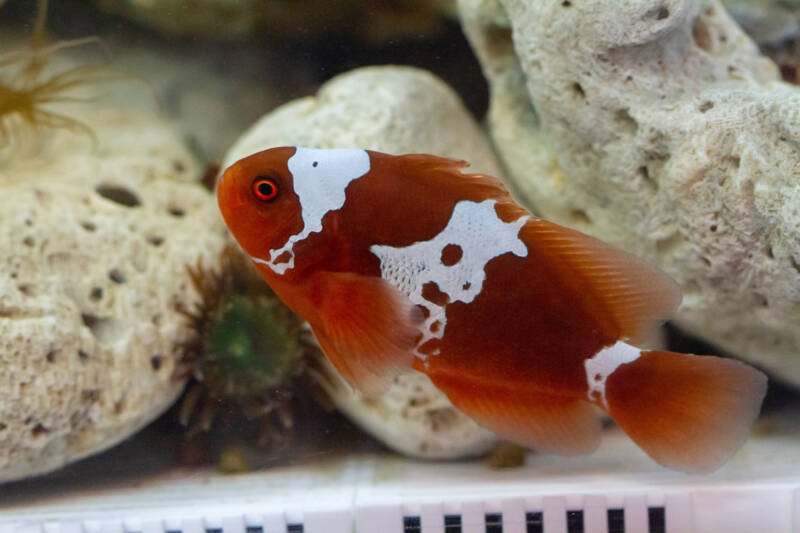
The amount of sleep fish require and sleeping habits vary by species. However, all fish need rest to be healthy and can suffer from sleep deprivation the same way that mammals and other animals can.
Read on for information on how to tell if your fish are sleeping, how often they sleep, and for how many hours.
[toc]
Do All Fish Sleep?
While most fish enter a period of rest, not all species enter a full “sleep” state.
Sharks are a well-known example of a marine animal that does not enter a deep sleep.
Some shark species, called obligate ram ventilators, must swim continuously to keep oxygenated water flowing through the mouth and gills.
Researchers believe that the spine stimulates this constant swimming, thereby allowing the brain to relax. These sharks enter brief periods of rest where only one-half of the brain sleeps at a time.
Another documented example of a wild fish requiring very little sleep is the Mexican tetra, or blind cavefish (Astyanax mexicanus).
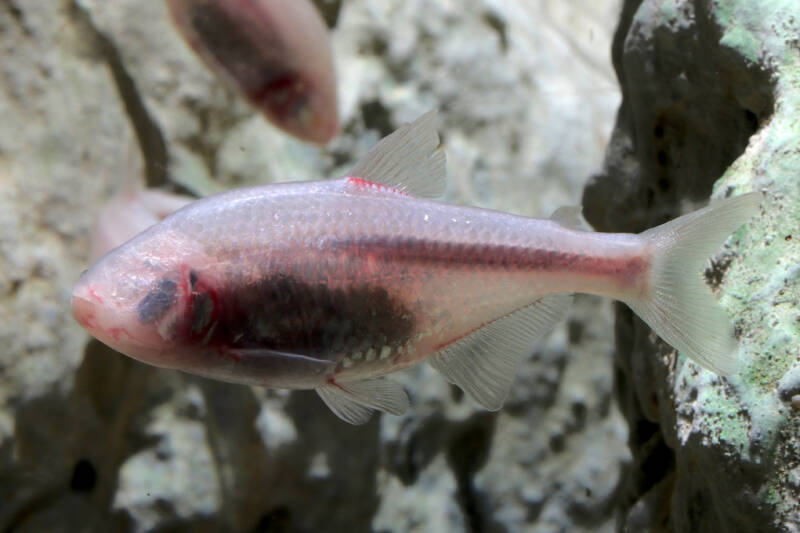
These fish are particularly interesting because they can be directly compared to the sighted surface variant of the same species.
Studies showed that although they share the same genetics, blind cavefish slept significantly less, up to eight times fewer minutes per day, than their sighted brethren.
Researchers determined that the gene for “insomnia” in these fish was dominant and hereditary, as cross breeding led to equally sleepless fish.
Several unique populations of cavefish displayed similar traits in a convergent evolution of this adaptation to their lightless worlds.
Most common aquarium species, however, will demonstrate resting periods that follow a general routine.
When Do Fish Sleep?
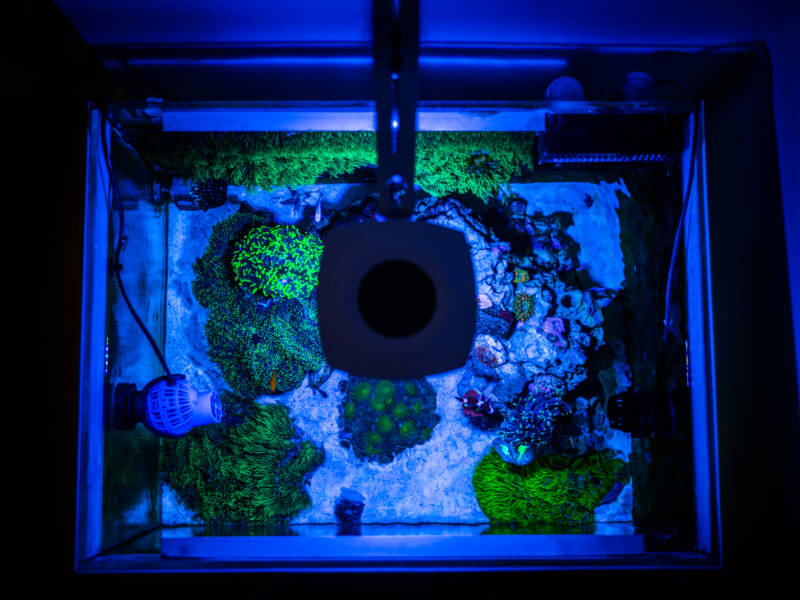
Fish naturally react to periods of light and dark to stimulate their activity levels, with the presence or absence of light cueing times of feeding and times of rest.
Fish that sleep during the day and are active at night are nocturnal species, such as catfish and some loaches.
Other fish are diurnal species, meaning they rest at night and are active during the day. These fish include many popular aquarium species, such as goldfish and tetras.
In nature, the sun’s movement stimulates these daytime and nighttime activities.
In an aquarium, this cycle is artificially replicated using aquarium lighting, which allows the fish to follow their natural activity rhythms.
Do not expect all species to strictly follow a routine. For example, the ever-popular betta fish sleeps primarily at night but has a habit of taking naps during the day.
How Long Do Fish Sleep?
Aquarium fish sleep for an average of eight to 12 hours.
Because sleep time is driven by light, plan to keep the aquarium lights on for eight to 12 hours, allowing for 12 to 16 hours of darkness.
If you tend to forget to turn off the lights, install a timer to keep things consistent. Too much or too little light will stress your fish and disrupt their natural activity cycles.
How Do Fish Sleep?
Fish sleep by slowing down their movements, including gill and fin motions. Their metabolism slows as well as their breathing, heart rate, and brain activity.
They enter some of the same sleep stages as do humans, such as slow wave sleep and deep sleep; however, there is no rapid eye movement during deep sleep.
Because they don’t have eyelids, they cannot close their eyes and therefore rest with their eyes wide open. Noting a reduction in your fish’s movement is the biggest clue that a fish is resting.
Can they sleep on their sides?
Yes. Betta fish can occasionally sleep on their sides, much to the dismay of first-time owners!
However, note that if they are doing this frequently, monitor them for other health issues, such as swim bladder disease.
Where Do Fish Sleep?
Different fish species rest in a variety of places.
Aquarium Bottom

Some species lie motionless near the bottom of the tank, usually tucked away among plants, rocks, or other hiding places.
This hiding serves a purpose, as fish are markedly slower to react to stimuli during their resting periods, making them vulnerable to predation.
Ensure your tank has adequate hiding places in which your fish can sleep; otherwise, they will be unable to rest as needed to be healthy.
A lack of sleep can stress their immune system, making them vulnerable to parasitic or bacterial infections.
Substrate

Other species will nestle on or burrow into the substrate. It may be alarming to see active fish that are typically in the middle to upper levels of the water column suddenly resting on the bottom of the tank.
Neon tetras are one example of a species that tends to hover above the substrate when sleeping.
Take care not to pair small substrate-resting species with larger nocturnal substrate feeders, as your tiny fish may be a tempting snack.
Water Surface
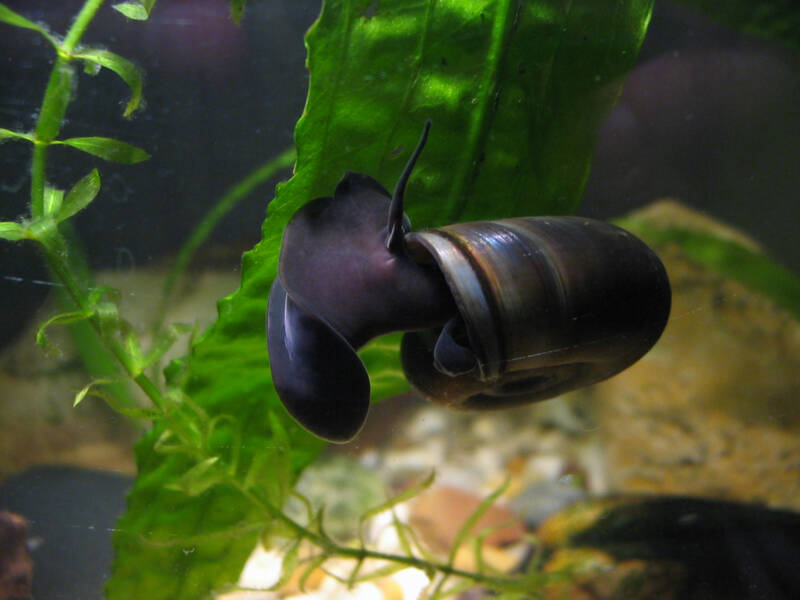
Other fish or snails may remain motionless near the surface of the water.
In the wild, aquatic animals that need to breathe air, such as turtles or dolphins, may rest near the water surface.
In an aquarium, some larger cichlids will hover, barely moving, in the open water during their periods of rest.
Guppies can float near the surface of the water for brief periods, which can give their owners a scare!
There are smaller fish species, such as the betta, that like to rest on plant leaves. It is quite an endearing sight to see your betta snoozing on an anubias leaf! You can even use artificial plants or special “betta hammocks” for your sleepy fish.
In many cases, where a fish sleeps is a matter of preference. You may find that your cichlid prefers a cave while your kuhli loach snuggles under leafy plants.
In any case, as long as your fish is following their normal activity levels and eating well, there is no cause for alarm if you see them wedged into a hiding space.
How Can You Tell if Your Fish is Sleeping?
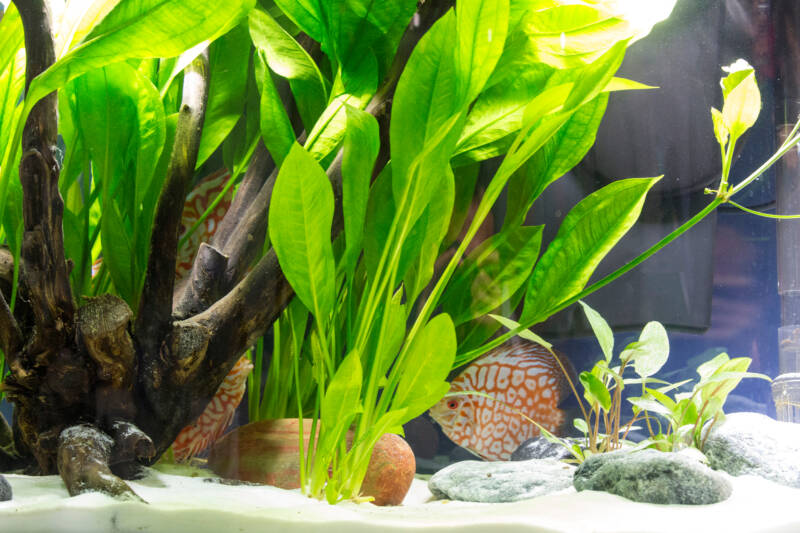
It can be alarming to come upon your fish lying motionless on the bottom of the tank and jump to the conclusion that they are dead.
First, know the activity patterns of your fish and whether they are typically active during the day or night.
You can also check for gill or mouth movement as well as the occasional tail or fin flick to determine whether your fish is sleeping.
If they are lethargic outside of their normal activity patterns, look for signs of illness.
Is There Such a Thing as a Fish Sleeping Too Much?
Aquarium fish will typically follow regular periods of resting and activity. If your fish resumes normal activity after a while, then it is likely that they were napping.
If they continue to be lethargic, begin checking for reasons.
Check the Water Parameters
Is the temperature set right? Water that is too cold can cause a reduction in activity for some fish.
Get out your testing kit and measure the pH, ammonia, nitrites, and nitrates.
Preferred temperature ranges and pH will vary by species, but the ammonia and nitrite levels should be 0 ppm. Strive for nitrate levels lower than 40 ppm.
Look for Signs of Illness
Learn the signs of common freshwater tank illnesses.
If your fish has a severe reduction in their activity levels accompanied by other symptoms, such as gasping, clamping fins, swelling, etc., then you should seek to treat them as soon as possible.
Other Factors
In the absence of poor water or illness, consider other factors, such as water flow or that your fish may be bored or overfed.
Avoid overfeeding your fish, as this can lead to other health issues in addition to sluggishness.
If you feel they may be bored, add plants, rocks, or other decorative items to make their environment interesting.
Look into the water flow rate, as some fish will seek out calmer water if the flow is too high.
Finally, know your fish species’ approximate lifespan. They may simply be entering their golden years and need a bit more rest.
Closing Thoughts
Fish do not sleep in the same way that we do, but all fish rest to maintain optimal health.
Knowing your fish’s sleeping habits can take away some of the anxiety you may have over a fish remaining still for an extended period.
To encourage your fish to hold a regular sleep schedule, keep a timer on your aquarium. In addition, provide ample hiding places or leafy plants for species that need a safe resting spot.
Let’s hear from you! What is the strangest sleep habit you have ever seen with your fish?
